 W
WIntergalactic travel is the hypothetical crewed or uncrewed travel between galaxies. Due to the enormous distances between the Milky Way and even its closest neighbors—tens of thousands to millions of light-years—any such venture would be far more technologically demanding than even interstellar travel. Intergalactic distances are roughly a hundred-thousandfold greater than their interstellar counterparts.
 W
WA1689-zD1 is a galaxy in the Virgo constellation cluster. It was a candidate for the most distant and therefore earliest-observed galaxy discovered as of February 2008, based on a photometric redshift.
 W
WA1703 zD6 is a strongly lensed Lyman-alpha emitter. It is located behind a foreground galaxy cluster known as Abell 1703, hence its name. It has a spectroscopically determined redshift of over 7, corresponding to a light travel time of 12.9 billion years. It is located in the Canes Venatici constellation. It was discovered in 2012, by a group led by L. D. Bradley, published in The Astrophysical Journal.
 W
WAbell 1835 IR1916 was a candidate for being the most distant galaxy ever observed, although that claim has not been verified by additional observations. It was claimed to lie behind the galaxy cluster Abell 1835, in the Virgo constellation.
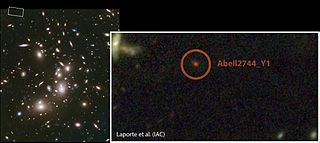 W
WAbell 2744 Y1 is a galaxy located in the Abell 2744 galaxy cluster, 13 billion light years away in the Sculptor constellation. It is 2,300 light years in diameter, 50 times smaller than the Milky Way galaxy, but producing 10 times more stars. The galaxy was discovered in July 2014 by an international team led by astronomers from the Instituto de Astrofísica de Canarias (IAC) and La Laguna University (ULL) as part of the Frontier Fields program with the help of NASA’s Spitzer and Hubble Space Telescopes.
 W
WAntlia-Sextans Group is a small grouping at the constellations Hydra, Sextans and Antlia. It is thought by some researchers to be at the very edge of the Local Group and thus part of it. Howewer, other researchers indicate it is an independent group, and thus the nearest group to the Local Group. It is, on average, approximately 4.3 million light-years away from the Milky Way.
 W
WA black hole is a region of spacetime where gravity is so strong that nothing—no particles or even electromagnetic radiation such as light—can escape from it. The theory of general relativity predicts that a sufficiently compact mass can deform spacetime to form a black hole.
 W
WA brightest cluster galaxy (BCG) is defined as the brightest galaxy in a cluster of galaxies. BCGs include the most massive galaxies in the universe. They are generally elliptical galaxies which lie close to the geometric and kinematical center of their host galaxy cluster, hence at the bottom of the cluster potential well. They are also generally coincident with the peak of the cluster X-ray emission.
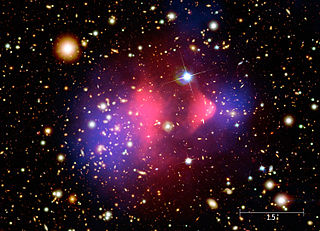 W
WThe Bullet Galaxy (RXC J2359.3-6042 CC) is a galaxy in the galaxy cluster RXC J2359.3-6042 (Abell 4067 or ACO 4067). The Bullet Galaxy is the sole component of one half of a cluster merger between the bulk of the cluster and this galaxy, which is plowing through the cluster, similar to how merging clusters Bullet Cluster and Bullet Group have merged. Unlike those two mergers, the Bullet Galaxy's merger is between one galaxy and a galaxy cluster. The cluster merger is happening at a lower speed than the Bullet Cluster, thus allowing the core of the Bullet Galaxy to retain cool gas and remain relatively undisturbed by its passage through the larger cluster. This cluster merger is the first one observed between a single galaxy and a cluster. The galaxy and cluster lies at redshift z=0.0992, some 1.4×109 ly (4.3×108 pc) away. The galaxy is traveling through the cluster at a speed of 1,310 km/s (2,900,000 mph).
 W
WCosmos Redshift 7 is a high-redshift Lyman-alpha emitter galaxy. At a redshift z = 6.6, the galaxy is observed as it was about 800 million years after the Big Bang, during the epoch of reionisation. With a light travel time of 12.9 billion years, it is one of the oldest, most distant galaxies known.
 W
WAccording to modern models of physical cosmology, a dark matter halo is a basic unit of cosmological structure. It is a hypothetical region that has decoupled from cosmic expansion and contains gravitationally bound matter. A single dark matter halo may contain multiple virialized clumps of dark matter bound together by gravity, known as subhalos. Modern cosmological models, such as ΛCDM, propose that dark matter halos and subhalos may contain galaxies. The dark matter halo of a galaxy envelops the galactic disc and extends well beyond the edge of the visible galaxy. Thought to consist of dark matter, halos have not been observed directly. Their existence is inferred through observations of their effects on the motions of stars and gas in galaxies and gravitational lensing. Dark matter halos play a key role in current models of galaxy formation and evolution. Theories that attempt to explain the nature of dark matter halos with varying degrees of success include Cold Dark Matter (CDM), Warm Dark Matter, and massive compact halo objects (MACHOs).
 W
WA deep-sky object (DSO) is any astronomical object that is not an individual star or Solar System object. The classification is used for the most part by amateur astronomers to denote visually observed faint naked eye and telescopic objects such as star clusters, nebulae and galaxies. This distinction is practical and technical, implying a variety of instruments and techniques appropriate to observation, and does not distinguish the nature of the object itself.
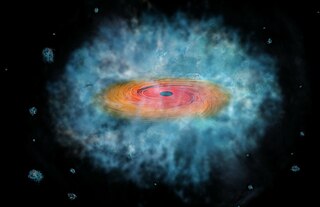 W
WDirect collapse black holes are high-mass black hole seeds, putatively formed within the redshift range , when the Universe was about 100-250 million years old. Unlike seeds formed from the first population of stars (also known as Population III stars), direct collapse black hole seeds are formed by a direct, general relativistic instability. They are very massive, with a typical mass at formation of ~105 M☉. This category of black hole seeds was originally proposed theoretically to alleviate the challenge in building supermassive black holes already at redshift , as numerous observations to date have confirmed.
 W
WA galactic disc is a component of disc galaxies, such as spiral galaxies and lenticular galaxies. Galactic discs consist of a stellar component and a gaseous component. The stellar population of galactic discs tend to exhibit very little random motion with most of its stars undergoing nearly circular orbits about the galactic center. Discs can be fairly thin because the disc material's motion lies predominantly on the plane of the disc. The Milky Way's disc, for example is approximately 1 kpc thick but thickness can vary for discs in other galaxies.
 W
WDLA0817g, also known as the Wolfe Disk, is a galaxy located in the constellation Cancer, 12.276 billion light-years from Earth.
 W
WDragonfly 44 is an ultra diffuse galaxy in the Coma Cluster. This galaxy is well-known because observations of the velocity dispersion in 2016 suggested a mass of about one trillion solar masses, about the same as the Milky Way. This mass was also consistent with a count of about 90 and 70 globular clusters observed around Dragonfly 44 in two different studies.
 W
WThe dwarf galaxy problem, also known as the missing satellites problem, arises from a mismatch between observed dwarf galaxy numbers and numerical cosmological simulations that predict the evolution of the distribution of matter in the universe. In simulations, Dark matter clusters hierarchically, in ever increasing numbers of halo "blobs" as halos' components' sizes become smaller-and-smaller. However, although there seem to be enough observed normal-sized galaxies to match the simulated size distribution, the number of dwarf galaxies is orders of magnitude lower than expected from simulation.
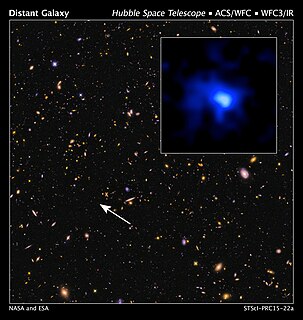 W
WEGS-zs8-1 is a high-redshift Lyman-break galaxy found at the northern constellation of Boötes. In May 2015, EGS-zs8-1 had the highest spectroscopic redshift of any known galaxy, meaning EGS-zs8-1 was the most distant and the oldest galaxy observed. In July 2015, EGS-zs8-1 was surpassed by EGSY8p7 (EGSY-2008532660).
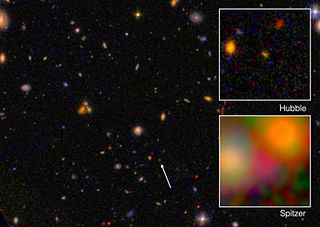 W
WEGSY8p7 (EGSY-2008532660) is a distant galaxy in the constellation of Boötes, with a spectroscopic redshift of z = 8.68, a light travel distance of 13.2 billion light-years from Earth. Therefore, at an age of 13.2 billion years, it is observed as it existed 570 million years after the Big Bang, which occurred 13.8 billion years ago, using the W. M. Keck Observatory. In July 2015, EGSY8p7 was announced as the oldest and most-distant known object, surpassing the previous record holder, EGS-zs8-1, which was determined in May 2015 as the oldest and most distant object. In March 2016, Pascal Oesch, one of the discoverers of EGSY8p7, announced the discovery of GN-z11, an older and more distant galaxy.
 W
WThe ergosphere is a region located outside a rotating black hole's outer event horizon. Its name was proposed by Remo Ruffini and John Archibald Wheeler during the Les Houches lectures in 1971 and is derived from the Greek word ἔργον (ergon), which means "work". It received this name because it is theoretically possible to extract energy and mass from this region. The ergosphere touches the event horizon at the poles of a rotating black hole and extends to a greater radius at the equator. A black hole with modest angular momentum has an ergosphere with a shape approximated by an oblate spheroid, while faster spins produce a more pumpkin-shaped ergosphere. The equatorial (maximal) radius of an ergosphere is the Schwarzschild radius, the radius of a non-rotating black hole. The polar (minimal) radius is also the polar (minimal) radius of the event horizon which can be as little as half the Schwarzschild radius for a maximally rotating black hole.
 W
WThe study of galaxy formation and evolution is concerned with the processes that formed a heterogeneous universe from a homogeneous beginning, the formation of the first galaxies, the way galaxies change over time, and the processes that have generated the variety of structures observed in nearby galaxies. Galaxy formation is hypothesized to occur from structure formation theories, as a result of tiny quantum fluctuations in the aftermath of the Big Bang. The simplest model in general agreement with observed phenomena is the Lambda-CDM model—that is, that clustering and merging allows galaxies to accumulate mass, determining both their shape and structure.
 W
WIn astronomy, a galactic bulge is a tightly packed group of stars within a larger star formation. The term almost exclusively refers to the central group of stars found in most spiral galaxies. Bulges were historically thought to be elliptical galaxies that happened to have a disk of stars around them, but high-resolution images using the Hubble Space Telescope have revealed that many bulges lie at the heart of a spiral galaxy. It is now thought that there are at least two types of bulges: bulges that are like ellipticals and bulges that are like spiral galaxies.
 W
WA galaxy is a gravitationally bound system of stars, stellar remnants, interstellar gas, dust, and dark matter. The word galaxy is derived from the Greek galaxias (γαλαξίας), literally "milky", a reference to the Milky Way. Galaxies range in size from dwarfs with just a few hundred million stars to giants with one hundred trillion stars, each orbiting its galaxy's center of mass.
 W
WThe galaxy color–magnitude diagram shows the relationship between absolute magnitude and mass of galaxies. A preliminary description of the three areas of this diagram was made in 2003 by Eric F. Bell et al. from the COMBO-17 survey that clarified the bimodal distribution of red and blue galaxies as seen in analysis of Sloan Digital Sky Survey data and even in de Vaucouleurs's 1961 analyses of galaxy morphology.
 W
WGalaxy mergers can occur when two galaxies collide. They are the most violent type of galaxy interaction. The gravitational interactions between galaxies and the friction between the gas and dust have major effects on the galaxies involved. The exact effects of such mergers depend on a wide variety of parameters such as collision angles, speeds, and relative size/composition, and are currently an extremely active area of research. Galaxy mergers are important because the merger rate is a fundamental measurement of galaxy evolution. The merger rate also provides astronomers with clues about how galaxies bulked up over time.
 W
WGalaxy Zoo is a crowdsourced astronomy project which invites people to assist in the morphological classification of large numbers of galaxies. It is an example of citizen science as it enlists the help of members of the public to help in scientific research.
 W
WGreen bean galaxies (GBGs) are very rare astronomical objects that are thought to be quasar ionization echos. They were discovered by Mischa Schirmer and colleagues R. Diaz, K. Holhjem, N.A. Levenson, and C. Winge. The authors report the discovery of a sample of Seyfert-2 galaxies with ultra-luminous galaxy-wide narrow-line regions (NLRs) at redshifts z=0.2-0.6.
 W
WA Hess diagram plots the relative density of occurrence of stars at differing color–magnitude positions of the Hertzsprung–Russell diagram for a given galaxy or resolved stellar population. The diagram is named after R. Hess who originated it in 1924. Its use dates back to at least 1948.
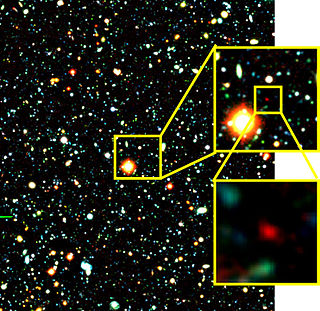 W
WIOK-1 is a distant galaxy in the constellation Coma Berenices. When discovered in 2006, it was the oldest and most distant galaxy ever found, at redshift 6.96.
 W
WA jellyfish galaxy is a type of galaxy found in galaxy clusters. They are characterised by ram pressure stripping of gas from the affected galaxy by the intracluster medium, triggering starbursts along a tail of gas.
 W
WLAE J095950.99+021219.1 is one of the most distant galaxies discovered as of yet, and has high scientific use, as it has revealed many important details of the early universe and emerging stars. LAE J095950.99+021219.1 is about 13 billion light years away and is in the top ten for distant objects in the universe. It is a Lyman-alpha emitter.
 W
WThis is a list of galaxies with richest known globular cluster systems. As of 2019, the galaxy NGC 6166 has the richest globular cluster system, with 39 000 globular clusters. Other galaxies with rich globular cluster systems are NGC 4874, NGC 4889, NGC 3311 and Messier 87. For comparison, the Milky Way has a poor globular cluster system, with only 150-180 globular clusters.
 W
WA Lyman-alpha emitter (LAE) is a type of distant galaxy that emits Lyman-alpha radiation from neutral hydrogen.
 W
WThe M–sigma relation is an empirical correlation between the stellar velocity dispersion σ of a galaxy bulge and the mass M of the supermassive black hole at its center.
MACS0647-JD is the farthest known galaxy from the Earth based on the photometric redshift. It has a redshift of about z = 10.7, equivalent to a light travel distance of 13.26 billion light-years. If the distance estimate is correct, it formed about 427 million years after the Big Bang.
 W
WNGC 3172 is a galaxy located in the constellation Ursa Minor. It is the closest NGC object to the North Celestial Pole. Discovered by John Herschel in 1831, it is about 285 million light-years away and about 85 thousand light-years across.
 W
WA Pea galaxy, also referred to as a Pea or Green Pea, might be a type of luminous blue compact galaxy that is undergoing very high rates of star formation. Pea galaxies are so-named because of their small size and greenish appearance in the images taken by the Sloan Digital Sky Survey (SDSS).
 W
WPGC 1 is a radio galaxy located about 1.1 billion light-years away in the constellation Pisces.
 W
WRD1 or 0140+326 RD1 is a distant galaxy, it once held the title of most distant galaxy known. RD1 was discovered in March 1998, and is at z = 5.34, and was the first object found to exceed redshift 5. It bested the previous recordholders, a pair of galaxies at z=4.92 lensed by the galaxy cluster CL 1358+62. It was the most distant object known to mankind for a few months in 1998, until BR1202-0725 LAE was discovered at z = 5.64.
 W
WSMM-J2135-0102 is a galaxy discovered using the Large Apex Bolometer Camera (LABOCA) of the Atacama Pathfinder Experiment (APEX) telescope.
 W
WSPT0418-47 is a young, extremely distant galaxy, discovered in 2020, surprisingly similar to the Milky Way, and looks like it was when the universe was only 1.4 billion years old. It is surprisingly non-chaotic and contradicts the theory that all galaxies in the early Universe were turbulent and unstable. It is located at a distance of about twelve billion light years from the Milky Way, where the planet Earth is located. The circular image shown below is due to the gravity of a different galaxy which focused the light from SPT0418-47 creating through gravitational lensing the circular image. Computer modeling was then carried out revealing a rotating disk and central bulge, as in the right image below.
 W
WA supermassive black hole is the largest type of black hole, with mass on the order of millions to billions of times the mass of the Sun (M☉). Black holes are a class of astronomical objects that have undergone gravitational collapse, leaving behind spheroidal regions of space from which nothing can escape, not even light. Observational evidence indicates that almost every large galaxy has a supermassive black hole at the galaxy's center. The Milky Way has a supermassive black hole in its Galactic Center, which corresponds to the location of Sagittarius A*. Accretion of interstellar gas onto supermassive black holes is the process responsible for powering active galactic nuclei and quasars.
 W
WThe thick disk is one of the structural components of about 2/3 of all disk galaxies, including the Milky Way. It was discovered first in external edge-on galaxies. Soon after, it was proposed as a unique galactic structure in the Milky Way, different from the thin disk and the halo in the 1983 article by Gilmore & Reid. It is supposed to dominate the stellar number density between 1 and 5 kiloparsecs above the galactic plane and, in the solar neighborhood, is composed almost exclusively of older stars. Its stellar chemistry and stellar kinematics are also said to set it apart from the thin disk. Compared to the thin disk, thick disk stars typically have significantly lower levels of metals—that is, the abundance of elements other than hydrogen and helium.
 W
WThe thin disk is a structural component of spiral and S0-type galaxies, composed of stars, gas and dust. The Milky Way's thin disk is thought to have a scale height of around 300–400 parsecs (980–1,300 ly) in the vertical axis perpendicular to the disk, and a scale length of around 2.5–4.5 kiloparsecs (8.2–14.7 kly) in the horizontal axis, in the direction of the radius. For comparison, the Sun is 8 kiloparsecs (26 kly) out from the center. The thin disk contributes about 85% of the stars in the Galactic plane and 95% of the total disk stars. It can be set apart from the thick disk of a galaxy since the latter is composed of older population stars created at an earlier stage of the galaxy formation and thus has less heavy elements. Stars in the thin disk, on the other hand, are created as a result of gas accretion at the later stages of a galaxy formation and are on average more metal-rich.
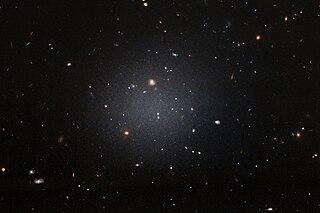 W
WAn ultra diffuse galaxy (UDG) is an extremely low luminosity galaxy, the first example of which was discovered in the nearby Virgo Cluster by Allan Sandage and Bruno Binggeli in 1984. These galaxies have been studied for many years prior to their renaming in 2015. Their lack of luminosity is due to the lack of star-forming gas, which results in these galaxies being reservoirs of very old stellar populations.
 W
WA void galaxy is a galaxy which exists in cosmological voids. Few galaxies exist in voids; most galaxies exist in sheets, walls and filaments that surround voids and supervoids. Many of the void galaxies are connected to each other through void filaments or tendrils, lightweight versions of the regular galaxy filaments that surround voids. These filaments are often straighter than their regular counterparts due to the lack of influence by surrounding filaments. These filaments can even be rich enough to form poor groups of galaxies. The void galaxies themselves are thought to represent pristine examples of galactic evolution, having few neighbours, and likely to have formed from pure intergalactic gas.
 W
WWISE J224607.57−052635.0 (or W2246−0526 for short) is an extremely luminous infrared galaxy (ELIRG) which, in 2015, was announced as the most luminous known galaxy in the Universe. The brightness is 350 trillion times that of the Sun (349×1012L☉), and the merger of smaller nearby galaxies may be contributing to its brightness. The light is generated by a quasar 10 billion times the mass of the Sun. The optical and ultraviolet light emitted by the accretion disc around the quasar's supermassive black hole is absorbed by the galaxy's dust and remitted in the infrared. The galaxy releases 10,000 times more energy than the Milky Way galaxy, although WISE J224607.57–052635.0 is the smaller of the two. WISE J224607.57–052635.0 has a light-travel distance of 12.5 billion light-years from it to Earth. The galaxy was discovered using the Wide-field Infrared Survey Explorer.